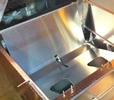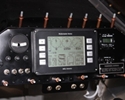


random user submitted photo
FYI
18 posts
• Page 2 of 2 • 1, 2
Re: FYI
I was once an Engineer and a Rocket Scientist and I was confused. Good luck following that....
- Scott Todd
- Posts: 374
- Joined: Mon Jun 24, 2019 7:40 pm
- Location: Chandler, AZ
Re: FYI
Thank you Wes. You reminded me of a lot of things I'd forgotten. My experiance with thermocouples, 30 years ago, was with chromel/alumel couples and temps around 3000 degrees. Steel castings. You hit the results dead center. In retrospect, the outside air temp blasting on the T2 connections was in the high 80's and that added to the T1 readings is close to the amount of the error. The recording instruments we used 30 years ago were compensated and very accurate and we didn't think about it. I posed the same question to MGL so lets see if they respond.
OneX 107
N2107X
N2107X
- Onex107
- Posts: 506
- Joined: Mon Mar 24, 2014 6:44 pm
- Location: Peoria, IL
Re: FYI
HI Scott,
OK, you've piqued my interest.
How does that work? Is it like smoking, drinking, chewing tobacco, or any of the other vices that afflict us? Did you wake up one day with an unusually strong resolve and declare that you were no longer a Rocket Scientist? What are you now?
Wes (tongue in cheek) Ragle
Scott Todd wrote:I was once an Engineer and a Rocket Scientist ...
OK, you've piqued my interest.
How does that work? Is it like smoking, drinking, chewing tobacco, or any of the other vices that afflict us? Did you wake up one day with an unusually strong resolve and declare that you were no longer a Rocket Scientist? What are you now?
Wes (tongue in cheek) Ragle
Wes Ragle
Onex #89
Conventional Gear
Long Tips
Hummel 2400 w/Zenith Carb
Prince P Tip 54x50
First Flight 06/23/2020
42.8 Hrs. as of 10/30/21
Onex #89
Conventional Gear
Long Tips
Hummel 2400 w/Zenith Carb
Prince P Tip 54x50
First Flight 06/23/2020
42.8 Hrs. as of 10/30/21
- WesRagle
- Posts: 899
- Joined: Fri Jan 05, 2018 12:35 pm
- Location: Weatherford, Tx
Re: FYI
It didn't happen overnight. I'm semi retired??? I got an AS in Electronics, BSE in Aerospace Engineering, and my Master Studies in Mechanical Engineering. I officially retired from Pratt&Whitney MANY years ago where I was a Design Engineer, and later did Thermal/Structural Analysis on Jet engines and Rocket Engines. I Worked on some cool stuff that doesn't exist and went to some cool places that are not really there ;)
Some of the cooler things I worked on were the NASP X-30, F-22 and F-23 nozzle design, SSME Engines and Fastrac turbo-pump. I spent a few years at Honeywell working on Jet engines. For the last 15 or so years, I've been the primary caregiver of three adopted kids (now 9, 14, 16) and not really worked a regular job. During this time I've done occasional Aerodynamic consulting and more recently some UAV work for the Army.
I stay current with my three Home-builts, helping others get ready for first flights, and test flying. I'm also a lifelong avid R/C modeler. So I kind of refer to the Rocket Scientist years as almost a past life :)
Some of the cooler things I worked on were the NASP X-30, F-22 and F-23 nozzle design, SSME Engines and Fastrac turbo-pump. I spent a few years at Honeywell working on Jet engines. For the last 15 or so years, I've been the primary caregiver of three adopted kids (now 9, 14, 16) and not really worked a regular job. During this time I've done occasional Aerodynamic consulting and more recently some UAV work for the Army.
I stay current with my three Home-builts, helping others get ready for first flights, and test flying. I'm also a lifelong avid R/C modeler. So I kind of refer to the Rocket Scientist years as almost a past life :)
- Scott Todd
- Posts: 374
- Joined: Mon Jun 24, 2019 7:40 pm
- Location: Chandler, AZ
Re: FYI
Very cool Scott. I've only recently become a rocket scientist after a long career in aviation stuff engineering. I did a lot of UAV stuff for your former sister company Sikorsky in the 1990s, namely the Cypher UAV. I've got one aircraft in the Smithsonian, the Sikorsky X2 technology demonstrator. Mostly I did a lot of FBW plus other stuff. These days I work on space & rocket stuff, still working for UTC (except we are RTX now).
I've been on the other side of the hill of a place that doesn't exist. We were out at the Nevada Test Site for a couple of weeks with the Cypher UAV. Cool place.
I've been on the other side of the hill of a place that doesn't exist. We were out at the Nevada Test Site for a couple of weeks with the Cypher UAV. Cool place.
Bryan Cotton
Poplar Grove, IL C77
Waiex 191 N191YX
Taildragger, Aerovee, acro ailerons
dual sticks with sport trainer controls
Prebuilt spars and machined angle kit
Year 2 flying and approaching 200 hours December 23
Poplar Grove, IL C77
Waiex 191 N191YX
Taildragger, Aerovee, acro ailerons
dual sticks with sport trainer controls
Prebuilt spars and machined angle kit
Year 2 flying and approaching 200 hours December 23
-

Bryan Cotton - Posts: 5489
- Joined: Mon Jul 01, 2013 9:54 pm
- Location: C77
Re: FYI
Wes. Am I to understand that heating or cooling the two wires anywhere but at the joint of the dissimilar metals will hot change the output at the copper joint? MGL says that the temp of the RDAC would not change the reading. Their add says the are cold junction compensated.
What appears to have happened is cooling the exposed ends of the thermocouple wire changed the output of the welded tip and the RDAC simply recorded what it saw.
All I know is that covering the exposed ends eliminated the error.
What appears to have happened is cooling the exposed ends of the thermocouple wire changed the output of the welded tip and the RDAC simply recorded what it saw.
All I know is that covering the exposed ends eliminated the error.
OneX 107
N2107X
N2107X
- Onex107
- Posts: 506
- Joined: Mon Mar 24, 2014 6:44 pm
- Location: Peoria, IL
Re: FYI
Hi Maurice,
Thinking of a TC as everything from the junction of dissimilar metals to the point at which those metals join copper, anything that changes the temperature at either end of the TC will change the measured voltage.
The reason I didn't include T2 in the statement,
is because in a carefully implemented system T2 is always a known quantity and the measured voltage is always corrected to the known T2.
Understand that careful implementation of CJ compensation is expensive and generally painful. In my professional life we used circular connectors (cannon plugs) almost exclusively. While measuring TCs not only was the cabling TC wire, the pins in the connector were specially machined TC pins. On the other side of the connector was more high quality TC wire which terminated at the PC board right next to an accurate temperature sensor. All voids around the board connection were filled with "copper pour" and the whole mess was potted. All that in attempt to know T2 to 0.1 Centigrade degree. Call it pride, call it specmanship, call it whatever, we went to extremes so the brochures could say we were accurate to within 1 Deg. C.
Smaller, less expensive systems can't/don't/won't go to all that trouble.
I guess the "real question" is : "Where is the CJ temperature measured?". Do they have a sensor inside the box? Is it out on the connector? Do they use the OAT sensor? How do they know the temperature right at the point where the TC wires transition to copper?
Wes
Thinking of a TC as everything from the junction of dissimilar metals to the point at which those metals join copper, anything that changes the temperature at either end of the TC will change the measured voltage.
The reason I didn't include T2 in the statement,
The point is that, assuming a properly implemented system, you can take a blow torch to a point between the sensing point and the measurement point and it will not effect the T/C reading until the T/C is shorted, burned in two, or the extreme temperature soaks to the TC wire end thus effecting T1 .
is because in a carefully implemented system T2 is always a known quantity and the measured voltage is always corrected to the known T2.
Understand that careful implementation of CJ compensation is expensive and generally painful. In my professional life we used circular connectors (cannon plugs) almost exclusively. While measuring TCs not only was the cabling TC wire, the pins in the connector were specially machined TC pins. On the other side of the connector was more high quality TC wire which terminated at the PC board right next to an accurate temperature sensor. All voids around the board connection were filled with "copper pour" and the whole mess was potted. All that in attempt to know T2 to 0.1 Centigrade degree. Call it pride, call it specmanship, call it whatever, we went to extremes so the brochures could say we were accurate to within 1 Deg. C.
Smaller, less expensive systems can't/don't/won't go to all that trouble.
I guess the "real question" is : "Where is the CJ temperature measured?". Do they have a sensor inside the box? Is it out on the connector? Do they use the OAT sensor? How do they know the temperature right at the point where the TC wires transition to copper?
Wes
Wes Ragle
Onex #89
Conventional Gear
Long Tips
Hummel 2400 w/Zenith Carb
Prince P Tip 54x50
First Flight 06/23/2020
42.8 Hrs. as of 10/30/21
Onex #89
Conventional Gear
Long Tips
Hummel 2400 w/Zenith Carb
Prince P Tip 54x50
First Flight 06/23/2020
42.8 Hrs. as of 10/30/21
- WesRagle
- Posts: 899
- Joined: Fri Jan 05, 2018 12:35 pm
- Location: Weatherford, Tx
Re: FYI
Hi Maurice,
A quick follow up. I googled MGL RDAC and found the manual on one of their units. Ref. https://www.mglavionics.co.za/Docs/RDAC%20XF%20INSTALATION.pdf
In that manual they state:
That implies that the reference junction temperature is measured at the amplifier. That is, inside the unit on the PCB. So, any difference in temperature between the connector outside the RDAC and the PCB inside the RDAC will be reflected as an error in TC readings.
Wes
A quick follow up. I googled MGL RDAC and found the manual on one of their units. Ref. https://www.mglavionics.co.za/Docs/RDAC%20XF%20INSTALATION.pdf
In that manual they state:
The thermocouple amplifier is a precision device providing full cold junction
compensation and bow voltage correction. In addition the amplifier measures
and corrects for its own errors.
That implies that the reference junction temperature is measured at the amplifier. That is, inside the unit on the PCB. So, any difference in temperature between the connector outside the RDAC and the PCB inside the RDAC will be reflected as an error in TC readings.
Wes
Wes Ragle
Onex #89
Conventional Gear
Long Tips
Hummel 2400 w/Zenith Carb
Prince P Tip 54x50
First Flight 06/23/2020
42.8 Hrs. as of 10/30/21
Onex #89
Conventional Gear
Long Tips
Hummel 2400 w/Zenith Carb
Prince P Tip 54x50
First Flight 06/23/2020
42.8 Hrs. as of 10/30/21
- WesRagle
- Posts: 899
- Joined: Fri Jan 05, 2018 12:35 pm
- Location: Weatherford, Tx
18 posts
• Page 2 of 2 • 1, 2
Who is online
Users browsing this forum: No registered users and 3 guests







